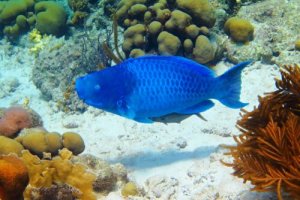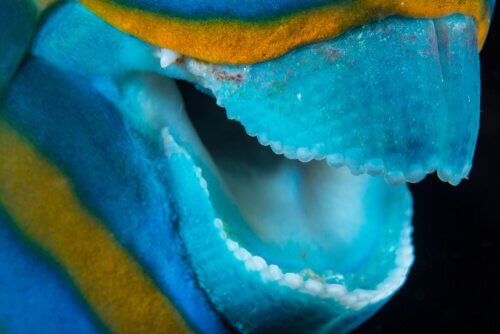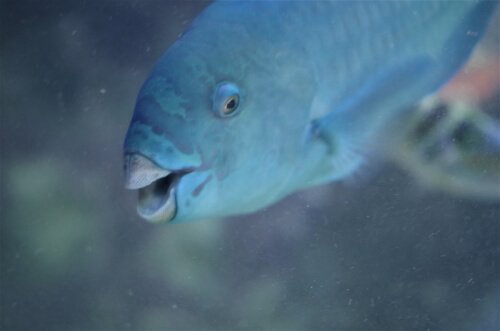Blue Parrot Fish: Information and Features

The blue parrot fish (Scarus coeruleus) is a marine species belonging to the Perciformes order of the Scaridae family. It is known for its colorful blue body.
Parrot fish are related to wrasse, and are found in abundance in the tropical reefs of the oceans around the world. There are some 90 species grouped into ten genera, and one of these is the blue parrot fish.
Characteristics of the blue parrot fish
The blue parrot fish is almost completely bright blue, a typical characteristic of the species of parrot fish of the genus Scarus. They are also known as blue parrots.
When they are young, they have a yellow spot on their heads that, as they grow, fades into a purple color until it becomes intense blue. This species has a life expectancy of about 20 years.
The adult specimens measure between 11 and 40 inches in length, and weigh approximately 65 pounds. Males are larger than females in most cases, and they also tend to develop humps on their heads.
The “parrot” name refers to its beak-shaped jaw, because its teeth are fused together. They use these teeth to scrape the algae from rocks and coral. They also have pharyngeal teeth, which are teeth inside the throat. Parrot fish use those teeth to crush the rocks and coral they digest. They then defecate them in the form of white sand.
This sand is the kind that we find on tropical beaches. For that reason, the parrot fish contributes to the formation of sediment that makes up the small islands and sandy beaches of the Caribbean. Each parrot fish can produce up to 450 grams of sand a year.

Distribution and habitat of the blue parrot fish
They live throughout much of the western Atlantic, from Maryland (United States), Bermuda and the Bahamas to Rio de Janeiro (Brazil), including the West Indies. However, they don’t live north of the Gulf of Mexico.
The blue parrot fish inhabits coral reefs at depths between 7 and 90 feet. Young fish live in seaweed and mangrove beds.
Diet and reproduction of the blue parrot fish
Their diet consists essentially of algae extracted from the coral chunks that come from the reefs. They bite the coral with the teeth in their throats to take off the algae polyps. Parrot fish spend 90% of their days feeding on excessive algae growth on coral. They also consume small benthic invertebrates in the sand.
The parrot fish is born with a defined sex, although in some cases, it can change its sex. Those who are born males will always be non-dominant males. However, when a female matures it can transform into a male, since females are born with the sexual organs of both sexes. This sex change ensures that there will always be at least one male to mate with all the females.
Males change a little in color during breeding season. They become brighter and more striking to attract females. In addition, males join large groups of females in order to fertilize their eggs.

Parrot fish are pelagic spawners, which means that they are grouped in an area of the ocean where the currents move the fertilized eggs so that they float out into the open ocean.
When the eggs open, the larvae float in the epipelagic zone, or the area of the open ocean near the surface. When the larvae become young fish (5 to 6 inches long), they descend into the reef ecosystem.
Conservation of the blue parrot fish
The blue parrot fish is currently a vulnerable species. This is due to several factors: overfishing, climate change, and ocean acidification by pollution. They are currently classified as a minor concern on the red list of threatened species of the International Union for the Conservation of Nature (IUCN).
Parrot fish and coral reefs have been related symbiotically for centuries. They cannot thrive without each other. The reefs provide shelter and food for the fish, and the fish, in turn, control the excessive proliferation of algae in the reefs.
By consuming them with their teeth, they break the stones and excrete fine sand. This contributes to the formation of the coralline island beaches of the ocean.
At present, these fish urgently need conservation strategies to curb human activities in certain areas where they live. This is the only way to preserve these wonderful fish and the marine ecosystems that they help maintain.
The blue parrot fish (Scarus coeruleus) is a marine species belonging to the Perciformes order of the Scaridae family. It is known for its colorful blue body.
Parrot fish are related to wrasse, and are found in abundance in the tropical reefs of the oceans around the world. There are some 90 species grouped into ten genera, and one of these is the blue parrot fish.
Characteristics of the blue parrot fish
The blue parrot fish is almost completely bright blue, a typical characteristic of the species of parrot fish of the genus Scarus. They are also known as blue parrots.
When they are young, they have a yellow spot on their heads that, as they grow, fades into a purple color until it becomes intense blue. This species has a life expectancy of about 20 years.
The adult specimens measure between 11 and 40 inches in length, and weigh approximately 65 pounds. Males are larger than females in most cases, and they also tend to develop humps on their heads.
The “parrot” name refers to its beak-shaped jaw, because its teeth are fused together. They use these teeth to scrape the algae from rocks and coral. They also have pharyngeal teeth, which are teeth inside the throat. Parrot fish use those teeth to crush the rocks and coral they digest. They then defecate them in the form of white sand.
This sand is the kind that we find on tropical beaches. For that reason, the parrot fish contributes to the formation of sediment that makes up the small islands and sandy beaches of the Caribbean. Each parrot fish can produce up to 450 grams of sand a year.

Distribution and habitat of the blue parrot fish
They live throughout much of the western Atlantic, from Maryland (United States), Bermuda and the Bahamas to Rio de Janeiro (Brazil), including the West Indies. However, they don’t live north of the Gulf of Mexico.
The blue parrot fish inhabits coral reefs at depths between 7 and 90 feet. Young fish live in seaweed and mangrove beds.
Diet and reproduction of the blue parrot fish
Their diet consists essentially of algae extracted from the coral chunks that come from the reefs. They bite the coral with the teeth in their throats to take off the algae polyps. Parrot fish spend 90% of their days feeding on excessive algae growth on coral. They also consume small benthic invertebrates in the sand.
The parrot fish is born with a defined sex, although in some cases, it can change its sex. Those who are born males will always be non-dominant males. However, when a female matures it can transform into a male, since females are born with the sexual organs of both sexes. This sex change ensures that there will always be at least one male to mate with all the females.
Males change a little in color during breeding season. They become brighter and more striking to attract females. In addition, males join large groups of females in order to fertilize their eggs.

Parrot fish are pelagic spawners, which means that they are grouped in an area of the ocean where the currents move the fertilized eggs so that they float out into the open ocean.
When the eggs open, the larvae float in the epipelagic zone, or the area of the open ocean near the surface. When the larvae become young fish (5 to 6 inches long), they descend into the reef ecosystem.
Conservation of the blue parrot fish
The blue parrot fish is currently a vulnerable species. This is due to several factors: overfishing, climate change, and ocean acidification by pollution. They are currently classified as a minor concern on the red list of threatened species of the International Union for the Conservation of Nature (IUCN).
Parrot fish and coral reefs have been related symbiotically for centuries. They cannot thrive without each other. The reefs provide shelter and food for the fish, and the fish, in turn, control the excessive proliferation of algae in the reefs.
By consuming them with their teeth, they break the stones and excrete fine sand. This contributes to the formation of the coralline island beaches of the ocean.
At present, these fish urgently need conservation strategies to curb human activities in certain areas where they live. This is the only way to preserve these wonderful fish and the marine ecosystems that they help maintain.
All cited sources were thoroughly reviewed by our team to ensure their quality, reliability, currency, and validity. The bibliography of this article was considered reliable and of academic or scientific accuracy.
- Moyle, P. y Cech, J. (2000). Fishes: An Introduction to Ichthyology. Nueva Jersey: Upper Saddle River.
- Smith, C.L. (1997). National Audubon Society field guide to tropical marine fishes of the Caribbean, the Gulf of Mexico, Florida, the Bahamas, and Bermuda. New York: Alfred A. Knopf, Inc.
This text is provided for informational purposes only and does not replace consultation with a professional. If in doubt, consult your specialist.








